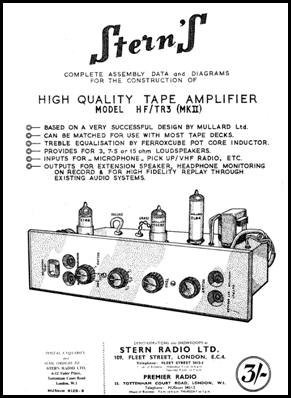Alan Taylor
…[I] used the school Ferrographs extensively but wanted a tape recorder which I could use at home. My parents couldn’t afford to buy one for me, but with my savings and a massive contribution from my parents, I was able to afford a tape recorder in kit form. I also made minor modifications to it to make it more versatile.
Nick Ware
Was it an Aspden tape deck by any chance? If you Google that, there’s a page from “Wireless World” Feb 1957 that shows an ad for it. Plywood deck plate. Valves underneath.
My next after that was a Collaro deck with Mullard Type C tape rec/rep amp (kit).
Then things got grander, with a Wearite (Ferrograph) deck, and again Mullard type C.
None of that helped get me into the BBC though.
Modest beginnings!
Alan Taylor
The original tape deck I had was a Collaro Studio deck. The valve electronics were bought as a kit from one of the shops in Edgeware Road. I can’t remember the name. They have long since gone. I also built a twin tape and twin record deck system for the school hall, using similar kits and decks (with Garrard SP25 record decks), to be used every day for playing music in assembly, but more importantly, for grams in school plays, some of which were quite sophisticated from an audio point of view.
With the hard-earned cash from my Saturday job, I later managed to buy a Brennell tape deck which had superficial cosmetic damage and was sold by my local HiFi shop for a clearance price. I wanted to have two tape recorders so that I could bounce recordings from one to the other and add extra material during the transfer. I had sussed out that I could get by with one of them only doing replay, so I built some transistorised tape replay pre-amps. It was mounted in a very stylish plinth, which was made from the polished walnut dashboard of a brand-new upmarket car – our neighbour worked at the car factory and asked my dad if he had any use for it.
Building transistorised record and erase electronics was far beyond my capability at that time. I never got round to building them as once I started working at the Beeb, I was able to afford a Ferrograph series 6, which I still have.
Dave Newbitt
Might your valve electronics kits have come from Sterns (Stern Clyne)? They did kits for all the Mullard designs, several of which I purchased and made up. I looked to see if I still had the assembly manual for the Type C tape amp but could only find those for the 3-3 series amps and the pre-amp. Happy days!
I also still have the thick full catalogues from Home Radio of Mitcham from the 1960s who were another brilliant source of components.
John Howell (Hibou)
… and here you are Dave, building a Stern-Clyne Type C tape amp with Chris Wilden. This was in 1963 in Hut 17 at Wood Norton during TO15.
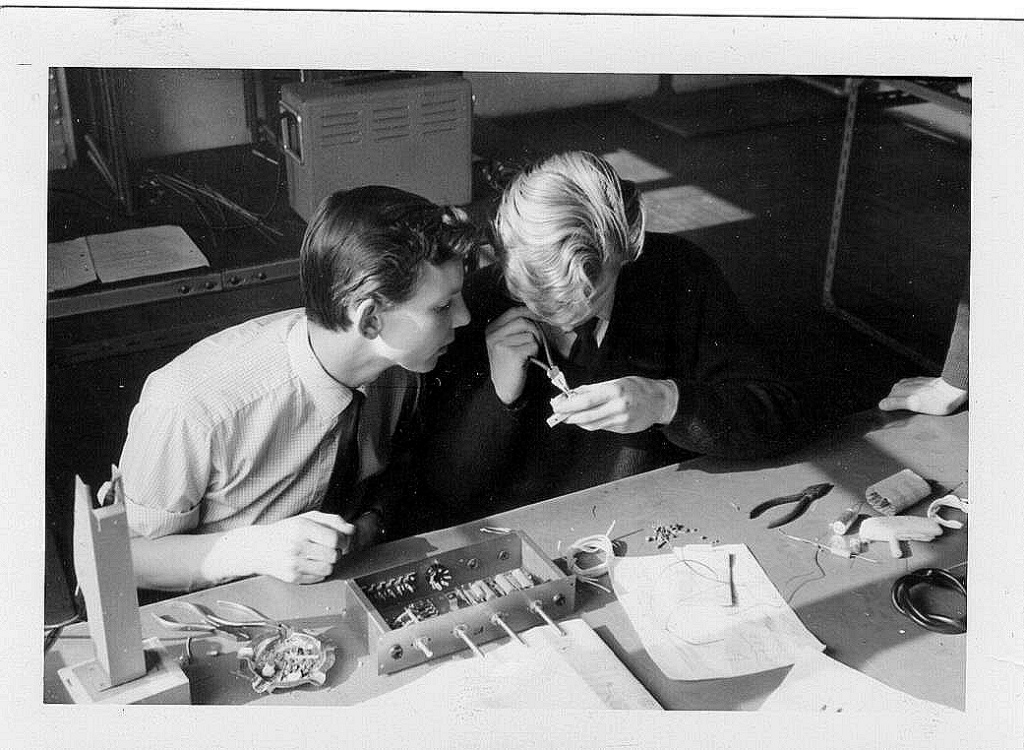
Dave Hewbitt
Goodness John – what a surprise! Thank you so much for digging it out, I honestly don’t believe I’ve ever seen it before. Being by nature an ‘in and out of the shadows person’ there are precious few records of me from that era.
I envy your filing system Hibou – I dig out old things for the forum sometimes but usually on the end of a lengthy search whereas you’ve pulled this up pretty smartly.
Alan Taylor
I think you’re right about the kit coming from Stern Clyne. It would have been from their Edgeware Road branch and the street number looks about right.
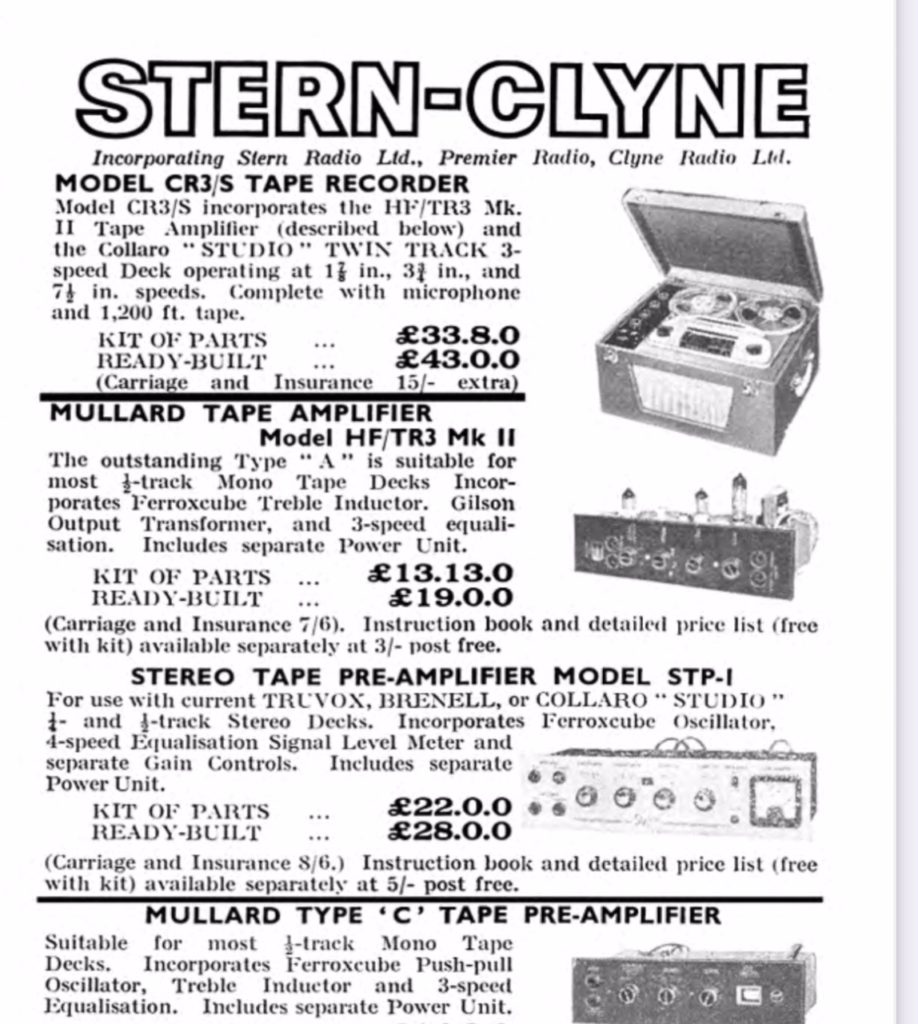
I didn’t think anybody would be interested, but just in case they are, here is a link to the construction manual for the tape recorder kit. At the end is a price list for accessories, which makes for fascinating reading
http://www.zen22196.zen.co.uk/scans/Stern’s%20Tape%20Amplifier%20Model%20HF-TR3%20(MkII).pdf.
In those days you really did build it yourself. No printed circuit boards printed with each component. The passive components were soldered onto tag boards and wired up to all the other components
Bearing in mind that I had only made projects using transistors up until then (red spot, white spot or OC71), it was quite daunting for a fifteen-year-old to be making a valve project of that complexity and even more daunting when the cost was such that it would have been a disaster if it hadn’t worked. No pressure!
Until I saw the manual, I had forgotten that the recording level indicator was a magic eye tube. I was already familiar with them because we had a Pye Fenman FM radio which used a different style of magic eye tube which displayed a fan shaped green area to indicate tuning. It would widen and narrow as you tuned around. I can’t remember the last time I saw one being used.
I remember the thing which most impressed the interview board. In order to set up the bias oscillator, the manual recommended using a valve voltmeter. I didn’t have access to one but built a simple transistorised device from a design in a magazine (“Wireless World”, or “Practical Wireless”). It was an adaptor for my multimeter, but it needed calibrating. I took it to school and during a lunch break was able to use the physic lab’s signal generator, multimeter and oscilloscope to calibrate it. It probably wasn’t accurate at other levels and frequencies, but the calibration was done at about the desired frequency and level, so it was probably pretty close.
Nearly all of those electronics shops in Edgeware Road, Tottenham Court Road, Lisle Street and elsewhere have long since gone. The other thing which went was the various surplus shops, which were an Aladdin’s cave of bits and pieces, with some great bargains to be found. I’m still using bits and pieces I remember buying from Greenweld in Southampton and there are doubtless many things in my loft which came from similar places.
Dave Newbitt
This has triggered off a bout of old literature rummaging and I found a long-forgotten treasure from the past. My copy of the “Mullard Circuits for Audio Amplifiers” surfaced, 2nd ed. (revised) 1962 – 136 pages price 8/6d! I would guess not too many of these will have survived. In those days you could ring up Mullard Laboratories and without difficulty find a knowledgeable chap who would be quite happy to spend 20 minutes talking to you about valve characteristics.
I remember also when building the Radford amp design needing the specified special twin gang pots. Couldn’t get them anywhere but I talked to Plessey who sent them to me gratis on a ‘sample’ basis. What a different world it was.
Dave Mundy
I built two Mullard 5-10s using the HQ valves from TVC test room bins!
ECC83 became 6057 (and the ECC81 was 6060 and so on).
I spent ages using the huge Avo valve tester to sort out the good from the not-so. I think I bought the kits up the Edgware Road from one of the Smith’s shops.
Once I knew about the existence of tape recorders in the late 1950s, I visited a local shop called Nottingham Tape Recorders and fell in love with a Tandberg which had three heads, but I couldn’t afford it so, I ended up with a Philips EL3538 3-speed valve machine which lasted me for many years.
After Evesham, I used to take it into work to ‘squeak’ it and adjust the azimuth, as you do! When I joined OBs in 1981, we often went to Nottingham for football etc. and visited Anchor Surplus, an ex-WD Aladdin’s cave of military stuff from rockets to cutlery! Once they had several Tandberg 15’s, 7″ three-speed half-track machines for £15! (used for language training). These machines were used in Production offices at TVC so I was able to get a copy of the Service Manual from Sound Test! I still have the machine!
Later on, my cameraperson on the Sports Unit, who helped out at his local church, got hold of the church’s Tandberg 3300X stereo cross-field head, 4-track, machine for me. It needed servicing and there was a private Tandberg service place in Doncaster, so we dropped it in on the way up North for a shoot! When I collected it, I had a brainwave and enquired whether the guy had any half-track machines and for a small amount extra I got one! Now I could play all of the fantastic Wood Norton stereo demo tapes which I had copied with the aid of Chris Daubney, lecturer! I still have the machine and the tapes!
Talking of Collaro Studio decks, one of our esteemed contributors had an article published in “Hi-Fi News” about how to convert the deck to vary-speed spooling just like the TR90 etc. I also have a deck given to me by an old VS at TVC!
Dave Newbitt
I too purloined double triodes from the same source [TVC test room bins] and still have a few somewhere. The number only valve refs were the Brimar Special Quality versions which seem to be what the Beeb usually had: 6057 for the ECC83 and 6060 for the ECC81. The Mullard SQ valves were respectively the M8137 and M8162, but I don’t recall ever coming across them in use at TVC.
John Howell (Hibou)
When I ‘rescued’ the amp. rack that served the echo rooms at TVC, I found 6060s in the three AMC5 mic amps. They tested ‘good’ once I had learnt how to use the AVO valve tester! I wonder how long these had been working? Originally there would have been three rooms but by the time I came to use them the first two had plates in them, but the third remained a room and you could move the ‘speaker and mic around for differing effects. So I guess the last time the set-up was tested would have been when the routable control of the two plates was installed, (in the mid-1960s?).
We don’t have any fault logs, but these amplifiers could have been working for 10 years or more I reckon this was the last valve equipment to be in use in the Television Centre unless anyone knows different.
The article about variable spooling for the Collaro tape deck appeared in “Radio Constructor” and I was paid 11 Guineas for it!
[Ed: A guinea was worth one pound and one shilling. This is £1.05 in modern money.]
Dave Mundy
Sorry, memories are not what they used to be! At least the TVC echo room was useable when it was raining outdoors!
The Lime Grove echo room had birds nesting in it and you could hear the rain!
I remember the plates in TC3 and TC4 and having to plug them up on CAR tie-lines for the use of OBs and setting the reverb time as requested. The Amibophony control unit was also installed in one of the SARs and Chris Daubney had the task of insalling the loudspeakers in TC1, TC3 and TC4 when he had joined Designs Dept. as his third-class Honours degree wasn’t good enough for Research Dept! TC1 was the nearest to perfection but we never had the orchestra in the correct position! I used to use the one in TC4 for the audience play-out music with ‘Bye-bye Blues’ after a sit-com.
I think Chris ended up at the IBA.
Dave Plowman
Ah – Ambiophony. Wonder how many times it was used successfully? At that sort of time I think we were short of the basics like mics – and had to use whatever was around. Seemed an odd way to spend a limited budget.
Pat Heigham
Mention of the Tandberg reminded me that they were used for Language Labs, to learn another language. However, my French teacher at school was years ahead, having a Vortexion, which used the Ferrograph deck, and a Reslo ribbon mic.
As I was the only ‘scientist’ in his class of A-Level Modern Language students, he put me in charge of the machine to record our efforts at French conversation. So that was my first official ‘recordist’ job! He also kindly lent it to me to make a commentary and music soundtrack to an 8mm film that I made of the school skiing trip one year. He brought it to our house, which made my mother somewhat weak at the knees, as he was extremely good looking! I knew nothing of synchronous recording at that time, trusting that the machine would run at a constant speed.
Mike Jordan
We had 2 Ferrographs available at school so a simple edit was possible. Also helped when I did a soundtrack for a film we made – I’ve still got the audio, but they lost the film – shame!
No studio of course but a good “understage” area also used as a gathering/drinks area (non-alcoholic of course)
The pile of wires on the right may be part of my built personal tape deck being built.
The nice switchbox on the left of the SMs corner was my first EMX construction – before I headed for BH Comms/Lines bit! The curtain handle is still there in use some 60years later, but I think they have replaced the 5A and 15A sockets.
I had to repair a tape I made in 1964 of Paul Simon singing at our school folk club and so had to get my splicing block out of the garage cupboard to enable repair since the Sellotape splices had given up.

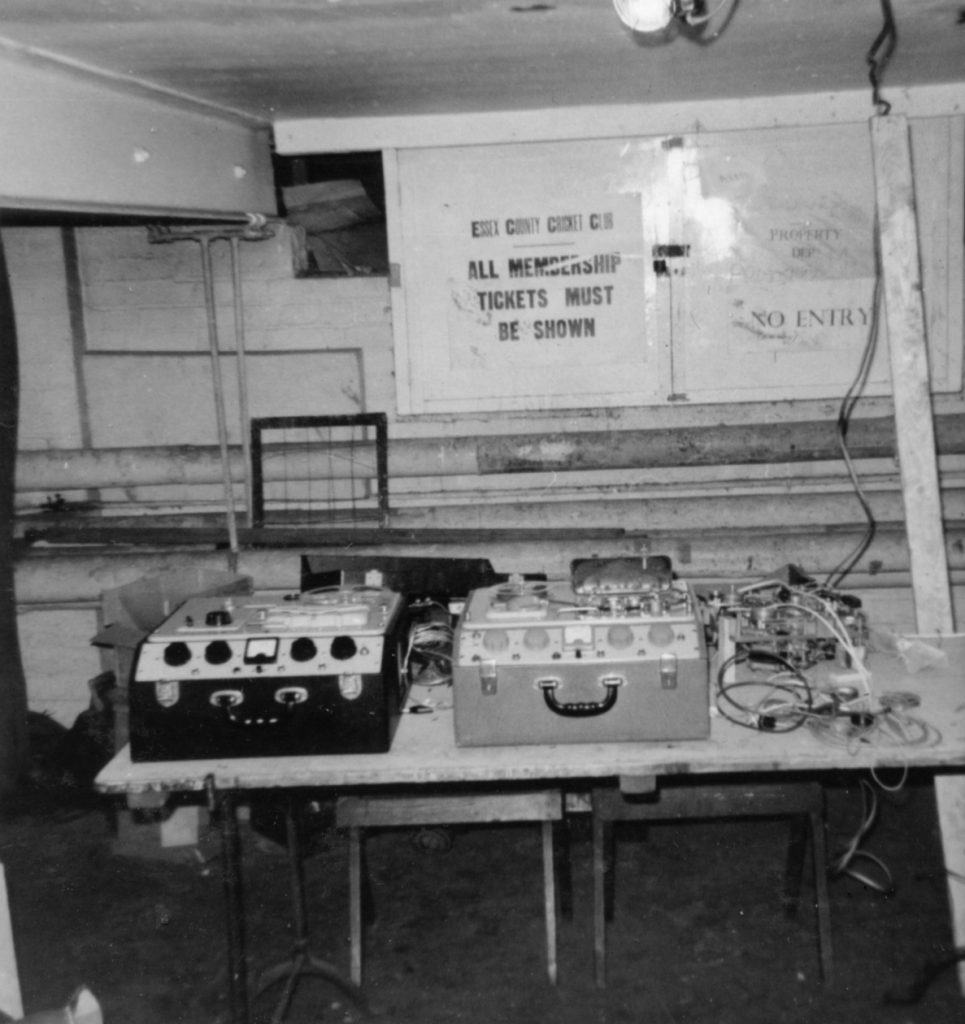
Alan Taylor
My dad was quite keen on photography and the company he worked for had quite an active photography club with a very well equipped darkroom. Being keen on tape recording, I was asked to help out a colleague of his who was making 8mm movies and had recorded sound on location. He couldn’t understand why he was experiencing synchronisation issues. You will all know why.
In those days, the only readily affordable portable tape recorders were the dreadful ones with no capstan. The take-up spool was driven at constant speed and dragged the tape past the head (if I remember right, it was a single head – erase might have been done by moving a magnet into contact with the tape).
He thought that the 3” reels of tape would be pretty well perfect as they would run for a similar duration as a small reel of 8mm film. His idea was to start the projector and tape recorder simultaneously, having cued them up with marks on their respective leader tapes. Obviously I immediately understood the problem, but he didn’t really believe my explanation. I ended up playing his tape and using a darkroom timer to time the duration, then rewinding and timing it again. I can’t remember the exact details, but do remember that two consecutive runs were more than a minute different in duration on a tape which ran for five or maybe ten minutes. I was expecting it to be different, but not that different.
He was disappointed about that, but I made up for it by showing him how I had made a very neat looking windshield for a dynamic microphone by using four cheap tea strainers with the handles sawn off (inspired by a magazine article). A sleeve of tin was made to be a friction fit on my microphone and was then poked through a microphone sized hole in the mesh and soldered into place. Two strainers (one with a similar hole) were soldered together to make a sphere and covered with fabric salvaged from mum’s nylons. The last strainer was slid over and taped around its equator. The nylon mesh ended up trapped between two concentric spheres. It worked well enough and looked the part too.
The guy really liked the look of it and made his own. Instead of tape, he glued them together with a new wonder adhesive called Araldite. He gave me a pack of Araldite as a thank you and I rebuilt my windshield accordingly. The remainder proved to be very useful in my model building projects.
I don’t think he ever got proper synchronous sound. He ended up doing mixed media shows using movies with unsynchronised music. The audio tape would be the master. The film started running on a cue soon after the music began. The tape kept playing after the film ended, becoming a commentary mixed with music with accompanying visuals from a slide projector. While this was happening, he would re-cue the film to the next section and run it again on the next cue. People watching didn’t seem to notice that he was using stills during the commentary, especially as the commentary could overlap the start of film sequences without being noticeably out of sync. I was impressed to observe how he planned and rehearsed everything to make it work seamlessly, despite the technical limitations. He also impressed on me how important it is to tell a story, rather than just showing pictures and playing sound.
Mike Jordan
A lot of my early stuff came from Henrys Radio of course (also in Edgeware Road) and I still have a catalogue somewhere in my pile of old stuff.
Earlier I had sourced switches etc from a shop down the road near school in Brentwood who stocked old military bits.
My first “Comms and radio” experience was in the CCF with 38 sets and telephone systems strung across the tents at annual camp.
My first home-built tape recorder also was bits from I forget where in Edgeware Road.
The attached is an example of how we used to make our own test equipment (actually inherited by the head man in BH Lines dept) and some spare valves if you want them. Somewhere I have an ACSP3 with date on just before my date of birth. Lovely silver thing with proper top cap.
The cable is of course how everything audio and video was sent around the UK. None of this glass stuff!
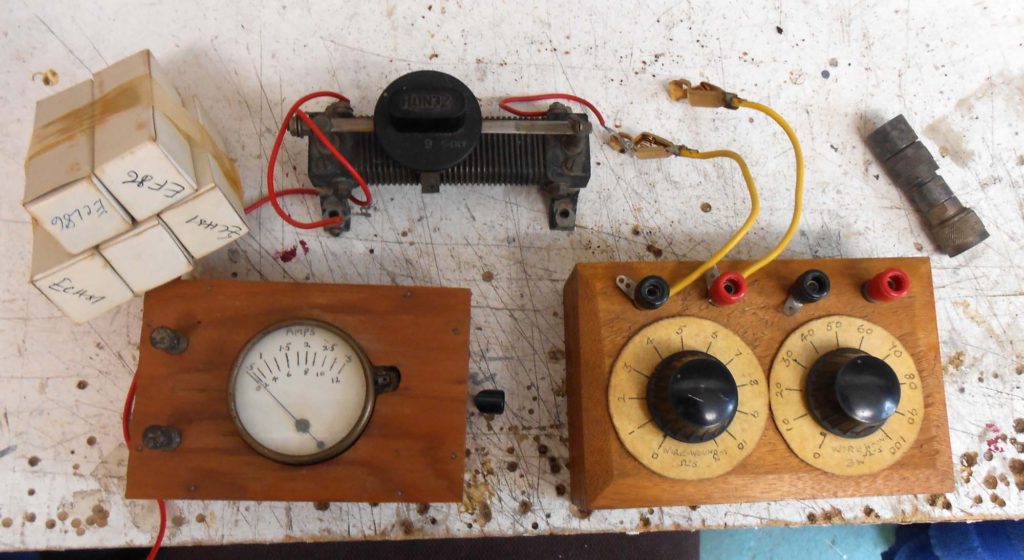
Dave Newbitt
Like Mike I have memories of CCF gear.
I spent some time in the school’s Signals Platoon with the 38 sets which I liked, and also with the 18 sets which I didn’t like – can’t remember why.
Back in the Signals Hut, I think it was a beefy 11 set we learned to operate. As commented elsewhere you can now pocket what used to require a fork-lift truck.
John Howell (Hibou)
At my school, the CCF had a portable PA system which consisted of a car battery, a control unit, several re-entrant horn ‘speakers and a mic with cooling fins. I subsequently found that it was a gunnery co-ordination system, it had no valves or transistors. the circuit can be described in one sentence: The mic draws current (up to 4 Amps!) through the primary of a step-up transformer, with its secondaries connected to the ‘speakers.
A vehicle headlamp bulb acted as a compressor and pilot light, when the current increased the bulb warmed up, its resistance increased and the current went down. The unit also had a calling configuration wherein the circuit could generate a calling signal at each gun position and the ‘speaker would turn into a mic so the gunnery officer could hear what the troops were doing.
The microphone was a wonderful device, seven little discs each resting in its own pot of carbon granules:
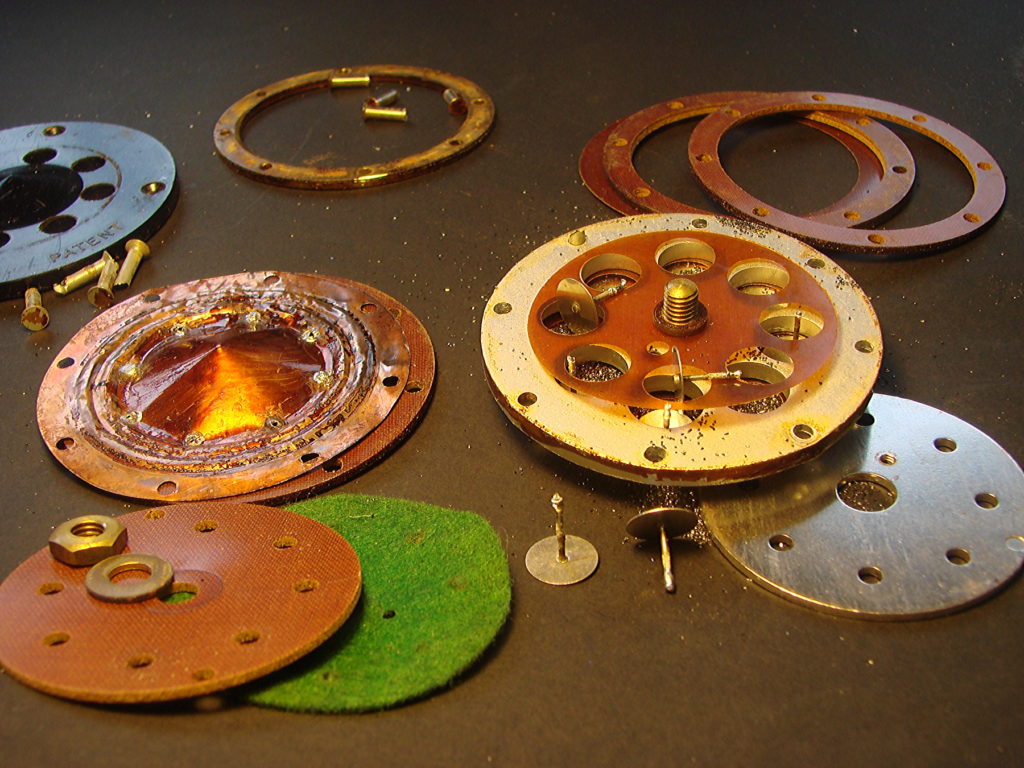
Stems from each disc were soldered to the main diaphragm to give a combined effort… and yes it did need cooling, the mic could dissipate up to 48 Watts peak.
We got it going, it sounded awful but it was intriguing because it had no active devices. It was made by Tannoy.
Alan Taylor
When I was about seven or eight (I know the age because of where I was living), I was given a Tannoy carbon microphone which had die-cast fins. I didn’t realise they were cooling fins, I just thought it must have been a styling feature. I never used it powered with more than a few volts so it never got warm nor loud. It was pretty hideous audio quality, but as a kid it was great fun to play with.
This picture shows one which is almost identical to the one I had.
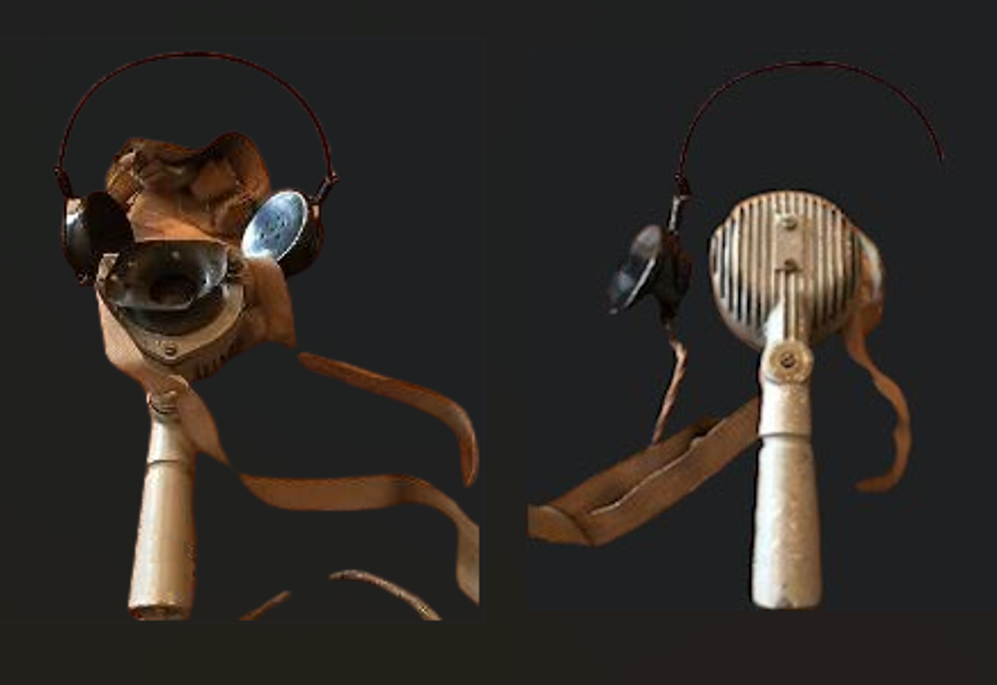
And back to Henry’s Radio
Bernie Newnham
I bought a pair of Henrys audio power amplifier modules for my system. The design unfortunately suffered from some kind of thermal runaway – got very hot and died. I took several back till maybe they did mods or I was lucky.
I’d completely forgotten that till you said “Henrys”.
Nick Ware
Henry’s Radio was home territory to me too. You could just about get there and back between your bit of “Blue Peter” rehearsal and the end of line-up, in the nick of time for TX! That and Proops in Tottenham Court Road, of course. And a bit later, Electrovalue in Englefield Green.
We had a fantastic little family-run radio shop in Guildford called Porters Radio, with a repairs and parts department opposite, run by a wonderful chap called Jim Green. My life wouldn’t have been the same without Jim’s inspirational knowledge and support. That’s where I got all my components from in those days, and needless to say, Useekia in Goldhawk Road for metalwork. Many mixers, etc., built thanks to Useekia!
At boarding school I was relentlessly bullied for not having any interest in sports. The only reason I got out alive was by constructing the radio controls for other boys’ model boats and aircraft. My staple diet being the XFG1 soft valve and coils hand wound on toilet roll cores, etc. And newly emerging on the scene was the Mullard GET106 germanium transistor. The only radio-controlled boat I built myself was electrically powered, and won me brownie points by rescuing other boys’ sail-powered boats stranded in the middle of Cheddar reservoir.
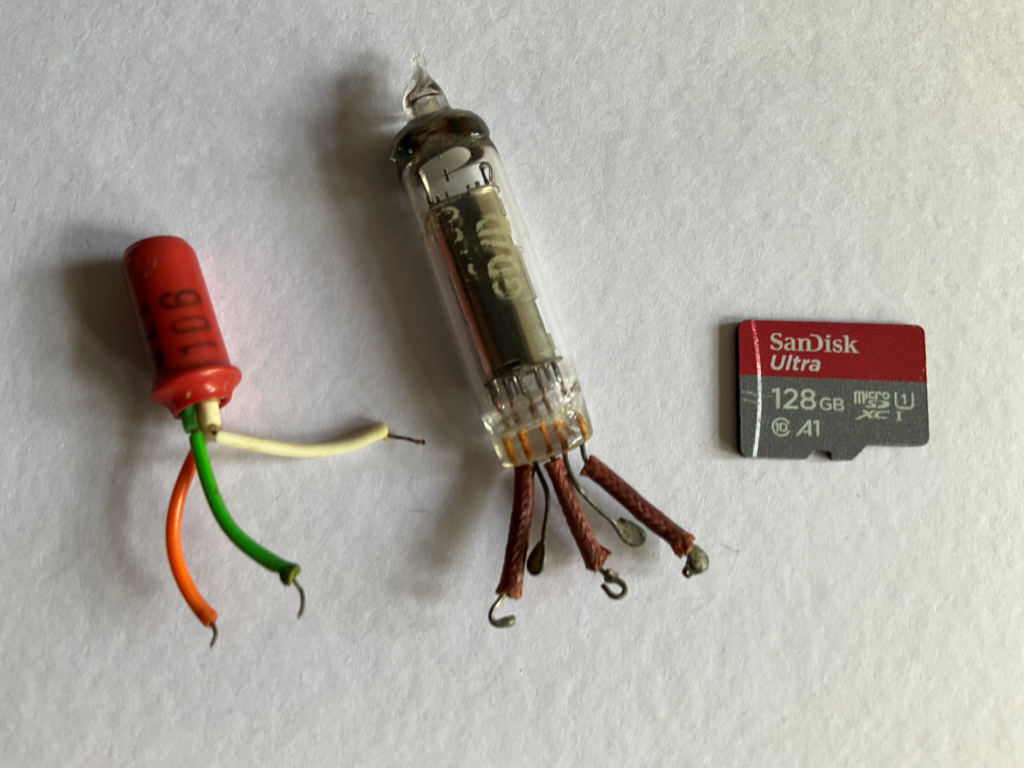
Do you ever look at those early beginnings alongside today’s technology such as, say, the 128GB micro-SD card in this pic and wonder where it might be in another 65 years from now?
With an 8-week-old granddaughter new on the scene [July 2022], I worry for her future a lot. I look at her and think: “…what will she see that I never will?…”
Pat Heigham
Nick – your comment about your new granddaughter (you old romantic, you!) reminded me that I was born in the house of an elderly aunt, who when she was a child, only had gas lighting, no electricity, but lived long enough to see man landing on the moon – on TV! Such is inventive progress. Who would have thought of mobile phones, even, and ones small enough to be a wristwatch.
Like Nick, I was uninvolved with sport and much more interested in the RadSoc (Radio Society) which operated after supper, before bedtime (I was a dayboy, so missed out on the after-school activities, but somehow managed to catch the last bus home). One guy owned a tape recorder, which sparked my fascination, and I’m still playing with them even now!
My first machine was more or less given to me by my village radio shop, it only needed a new valve, which cost me 50/-, and can be seen at the bottom of the enclosed photo of my home cinema. The overgrown jackplug is a radio jack, so I could listen to Light programme comedies.
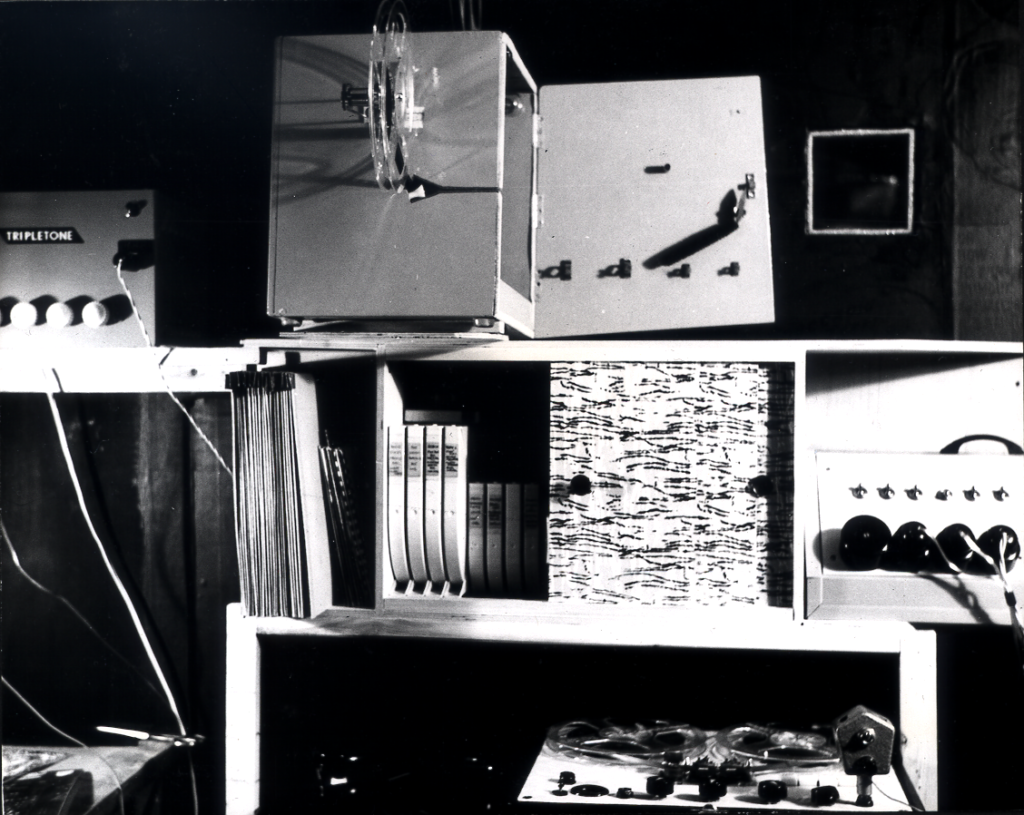
Knowing that the BBC required A levels in Physics and Maths, I attended Ewell Technical College, now renamed NESCOT, but didn’t do so well in the exams. However, I was running the Film Society, and I think the Principal gave me such a good testimonial, that the BBC accepted me, nevertheless.
Dave Buckley
The only valve amp I have ever built was way back in 1966 – made by Heathkit.
However, while working at AP around the same time, one of the recordists in the Film Transfer area built a double Williamson amp, and brought it in one Sunday (things were very quiet on a Sunday in those days), to do a frequency test.
He was a bit puzzled to find that it had a ‘hump’ in the response at about 23kc/24kc.
After trying to get the amp ‘flat’ by changing some components, he plugged the frequency generator into the detector and found that it was the test equipment that had the hump!
I reminded him of this many years later when he came to TV Training as part of film crews from Ealing shooting films for trainee Directors.
One of the ‘jobs’ I did at TVT was an annual check of the valves (low noise EF86s) in some C28 mics which had been declared redundant, so were ‘re-routed’ to the department. We kept four of these permanently rigged on low mic stands for interviews (before tieclip mics became the norm).
As they powered up whenever the studio was in use (whether or not the mics were actually used) in the years that the department had them, I think I only changed one valve. The mic test room at Avenue House had supplied a few spare valves and quite a lot of other spare parts for the mics.
Nick Ware
Not wanting to nit-pick, but I don’t think I ever saw a C28 with an EF86 in it. It was supposed to be a 6072 double triode (ECC83 equivalent, IIRC), not a pentode. The valve was for impedance matching between the 120VDC polarised capsule and the output transformer, not for gain as such.
Dave Newbitt
Ah, the 6072 – General Electric’s (GE’s) top quality version of the ECC83 and apparently the bee’s knees version at that. Seems you can still find them across the pond at $200 or so!
[It is a] long time since I had occasion to look at valve prices, but looking now I wonder why $200 seemed a lot of money for a GE6072. I see a Telefunken EF806S (SQ version of the EF86) as used in the Neumann U67 is a cool $500 in the States.
Nick Ware
Or the even more rare AC701k as used in the KM54, among others. NOS on eBay for $2995.00! I know I had a spare unused one of those that came with a pair of ex-Decca KM54’s that I once owned, but I’m damned if I can find it. I think it must have gone to Funky Junk with the mics.
Dave Newbitt
Will it find a buyer at that price? If ‘yes’ it looks like a case for hoarding rather than de-cluttering when you next have a clear out.
Chris Woolf
It is wonderful to hear of the first efforts of making tape-recorders and amplifiers – and yes, I remember Henry’s and Proops, Brenell decks et al.
Geoff Hawkes
I wanted a tape recorder in the late fifties when I was still at school. I favoured a Grundig because the minister of our church had one which he used to record the services to take round to the shut-ins and he brought it to our house one time when my dad was ill and it looked impressive.
I’d originally thought of a Grundig Cub as I couldn’t afford one like he had, and I’d seen adverts for the Cub and thought it looked good but was glad I didn’t as I was told it didn’t have constant speed drive (have I remembered that right?). Instead I got one from a shop in Richmond using my paper round money. It was badged with the label “Sound”, which I’d never heard of, and it had a Collaro Studio deck, like Alan had, though I’d never have attempted to build one like he did as that was beyond my capabilities or interest. I still have the machine today, see picture, though I haven’t attempted to run it for decades and am not sure it still works.

In the newsagents shop I’d seen the monthly magazine “Tape Recorder” aimed at the growing hobbyist/enthusiast market and I bought it and each month read it avidly. In it was an ad for a book called “How to get the best out of your tape recorder” by one Percy Guy, “…a lecturer at the BBC’s ETD, Wood Norton” which I read from cover to cover. That was while I was still at school and well before I had any inkling of what I wanted for a career.
Having later seen the advert for Technical Operators at the BBC and being persuaded by my dad to apply, come the day for my recruitment interview in June 1963 at Langham House: on the board was one John Eadon-Eden who quizzed me on the machine to probe me about how much I knew. He asked what deck it had and when I told him it was a Collaro Studio deck he seemed to know it, which surprised me. He asked how many motors it had, what they did and what type they were, which I got mostly right except I’d forgotten that the one driving the capstan was a synchronous motor, not an induction one like the others.
He asked how many heads it had and which came first – which I knew – and I was able to tell him about the mu-metal head covers and the azimuth adjustment which I’d tried tweaking in accordance with what the book had said to try and eliminate cross-talk between the tracks. I’d also done a bit of classic cut and join tape editing which I could describe.
There were questions about mics and sensitivity patterns, omni, cardioid, figure of eight which he seemed pleased that I knew something about and though I was probably a bit slow at solving the quadratic equation they gave me which I guess was at least partly to see how I’d respond under pressure, or in quoting Ohm’s Law (remember all that?) I think that and the answers I gave about photography and basic Portrait Lighting was what got me the job. I wished later that I’d mentioned the book and said glowingly how I’d like to meet the author but didn’t think of it at the time. When on my TO Course I did meet him and realised what an overbearing, somewhat stern character he was, I didn’t have the nerve to say anything more than “yes sir, no sir”, and certainly not to ask for his autograph on the book.
My placement after Evesham was on Sound and from what I was told it seemed clear that they had earmarked me for a job in Sound, which while I “enjoyed” a bit of boom-oping on shows like “Compact”, photography was my main interest and I had in mind being on Cameras. I still shudder when I remember playing in the wrong track on the recording of a boring factual show in TC5, instead of the closing music as I hadn’t cued it up correctly. Do tell me that I’m not the only one to do something like that!
Mike Giles
Geoff’s photo reminds me that I had one of those decks, supplied in a kit of parts which was simply complete entities to join together and fit into the plywood box which they supplied, no technical knowledge required.
Before that, I had been given a “tape deck” which sat on a record player turntable to get its motive power ~ I can remember no detail except that the tape speed varied according to the fullness of the spools. My uncle had first introduced me to the magic of recording at the tender age of six or seven ~ he had what must have been a very expensive “Sound Mirror”, which had a beautiful rosewood cabinet and a very large speaker for the time. It had a permanent magnet erase head and I recall that the most fascinating thing for me at that age was the magic eye record level indicator ~ whereas all the oldies were amazed at hearing themselves back, I rather took that for granted ~ much like my grandchildren who have lived with mobile phones for their whole lives ~ the technology still amazes me, but they simply expect it.
Your recruitment interview sounds very stiff compared with mine, Geoff ~ whilst I certainly talked about having joined a tape deck, a pre-built amplifier and a loudspeaker together in a box, I think more time was spent talking about the fact that I had built a canoe! I don’t remember any maths or physics coming into it. That there was not even the need to have actually passed A level exams ~ merely to have studied maths or physics to A level standard.
But I also recall that at Evesham I incurred one lecturer’s pseudo wrath by getting 100% in one of his tests ~ he declared that it was not what was expected of new recruits! But I think I made up for that with plenty of mistakes throughout the rest of my career ~ you were definitely not the only one!
Pat Heigham
I think that was the GramDeck.
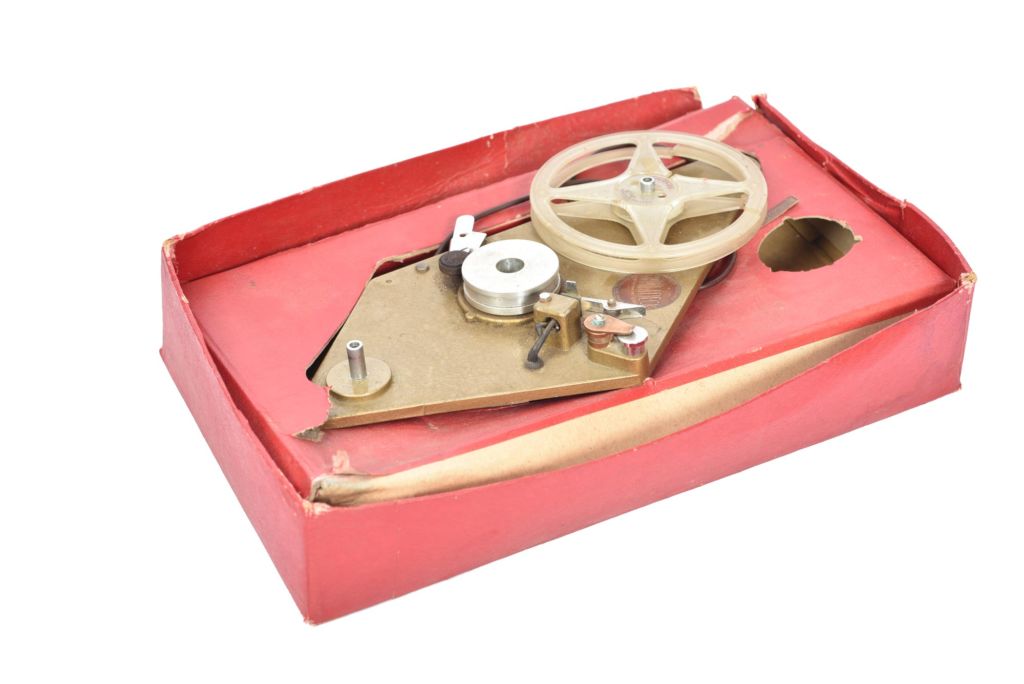
George Auckland
I don’t normally join in since I seem a bit of a fraud amongst the engineers. However I could not resist this one from you. The tape deck which sat on a gramophone could have been a Gram Deck.
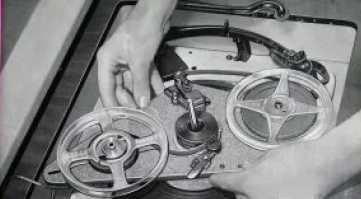
I had one that ran well at 7 1/2 ips with the record deck at 78 rpm. It was not great for music but excellent for speech. If you put one on a wind-up gramophone you got a portable tape recorder, since the recording amplifier was battery driven. When I was about 15, I made my first on location sound movie with such a setup and a clockwork 16mm Bolex. We could get about 25 seconds of reasonable constant speed on the camera per wind. We had to break the dialogue down into short chunks, which was probably no bad thing. I always processed my own Black and White film so the whole thing was relatively cheap, if a bit complicated. However we loved it.
Mike Giles
That makes two of you, Pat and George, who have named the same device ~ the Gram Deck ~ and I certainly remember that it was a bit like the photo. But mine definitely didn’t maintain a constant speed ~ it required that replay was from a spool with the same tape content, in order to play at the right speed. I didn’t experiment with it for long, so perhaps I missed a trick.
Peter Fox
“… I was told [the Grundig Cub] didn’t have constant speed drive…”
[Geoff was] right about the Grundig Cub Geoff, it was driven from the take up spool so could only be played back on the same machine.
I did manage to rescue some of my uncle’s family tapes by playing them back on a Revox and tweaking the speed control throughout to keep the voices sounding more or less as I remembered them. Clearly not precision stuff but good enough.
Pat Heigham
Now for a history of tape recorders [I have] owned:
Apart from the unknown make, mentioned elsewhere, I dearly hoped that my parents would buy me a tape recorder – each birthday I hoped, and hoped, but eventually I had saved up enough for a Philips.
This was 4-track, which saved on tape stock, but any recordings still held in library are unplayable without a four-track head. (Mike McCarthy managed to rescue some recordings of a friend’s wedding, made some 50 years ago!). Then I acquired a TruVox deck, which produced extremely good recordings, but again 4-track. I sold it to lovely Bryan Forgham, a very pleasant Sound Supervisor that I often worked with.
I was amused, as in the Bond film “You Only Live Twice” there are twin Truvox decks, built into Tanaka’s private train. As it’s supposed to be in Japan, I would have thought it better to incorporate a Japanese product. In fact, talking to the set designer later, it became the norm to ‘product place’ Sony equipment, and I took advantage of the discount offered to the Bond productions!
Then, some naughtiness on my part… As a Gram Op, editing music tapes or prepping for a production, in the 1960s there was a shortage of facilities to do these tasks, frequently I went to BH or even Bush to use a control room. So I bought a Revox 736 (G36) as it would handle 10 1/2″ NAB spools, to edit at home. This was dodgy, as the master tapes were very valuable, but we were usually tasked with bringing, in our cars, tapes resulting from music sessions from all over. (There was a thought that we should not travel with them on the Tube, sitting over the motor, for fear of accidentally wiping the tapes, but I never knew whether this was ever put to the test!). The problem was that the domestic model of the Revox, was initially 7 1/2 and 3 3/4 ips. Through the dealer that I went to, I got the factory to modify the machine to run at 15 and 7 1/2 ips. So the jobs got done.
The Sound Office at TVC had a couple of recorders which could conceivably be used to gather FX. One was a Fi-Cord, which I was allowed to take down to the Isle of Wight to record the sounds of the chain ferry across the Medina River from East to West Cowes. BBC production? No! this was for an 8mm film I had made! There was a Nagra, which Nick Ware was not allowed to borrow, although he had one of his own!
Going freelance, I gravitated to owning Nagras, an IV-S and later the I-S. It was a couple of delightful trips to go and fetch them from the factory in Switzerland! Their chief sales guy, Ray Trost, was pleased to meet up with actual users of the products and was very keen to have the machines properly set up for the tape stock in use.
I sold the I-S to a chap who liked to make 16mm movies, as a hobby, at a ridiculously low price, but still have the IV-S with the NAB adaptor. That latter piece of kit has a history. A sound crew, working in France, I think, were involved in a fatal road accident in which the Boom Op, Gary Weir? lost his life. The equipment banged around inside the truck – the adaptor suffered considerable damage, which David Lane – a super Nagra service engineer, managed to put right. Sadly, David himself passed away, having been Richmond Films’ in-house engineer for some years.
Sorry to end on a sad note.
Bernie Newnham
Here are some[tape] decks … from Amberley Museum.
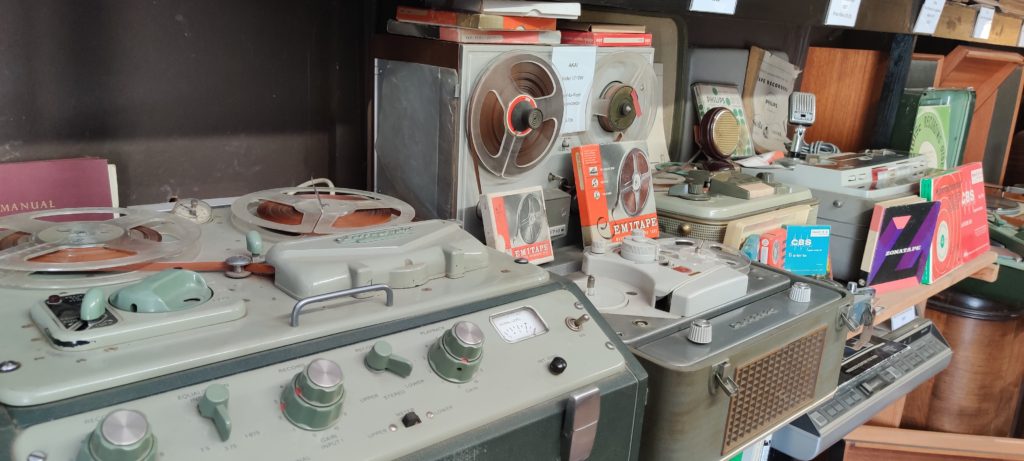
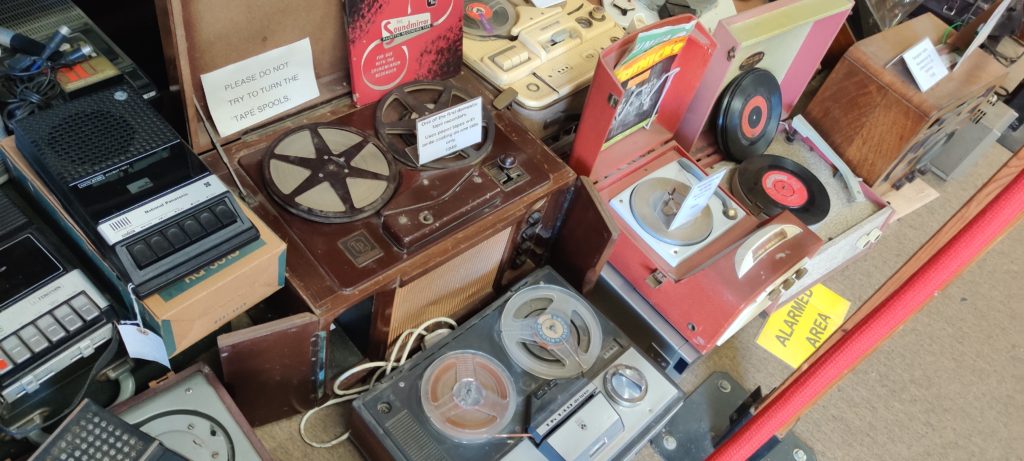
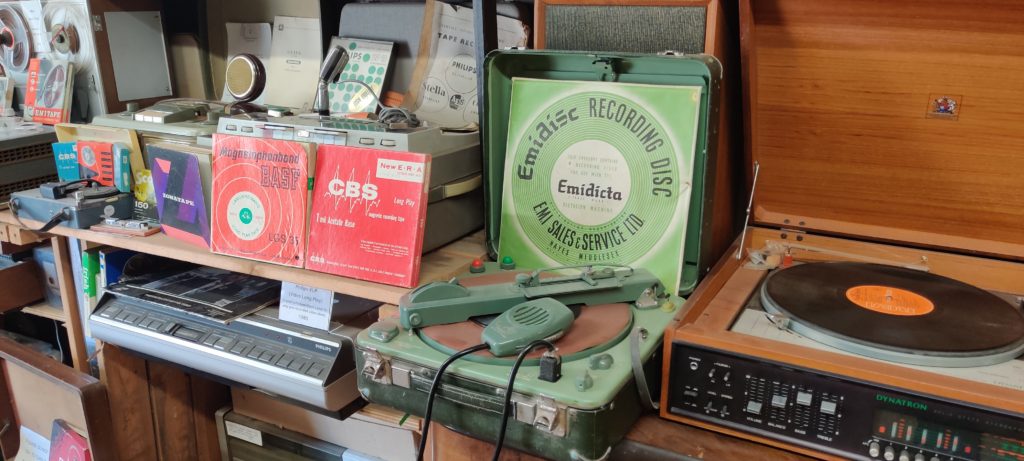
Mike Jordan
Yes, the Amberley Museum radio/TV shed is absolutely AMAZING!
Everything from a Crystal Set (didn’t we all start with one of those) to a modern flat-screen LED.
My visit there a couple of years ago to see MCR21 – which was only scheduled for a few hours – lasted ALL day to take in the radio shed/Electricity shed/Communications shed and also of course the grounds with people making real things in wood etc.
In total a shedload of brilliant stuff!
Dave Mundy
Part of my personal museum!
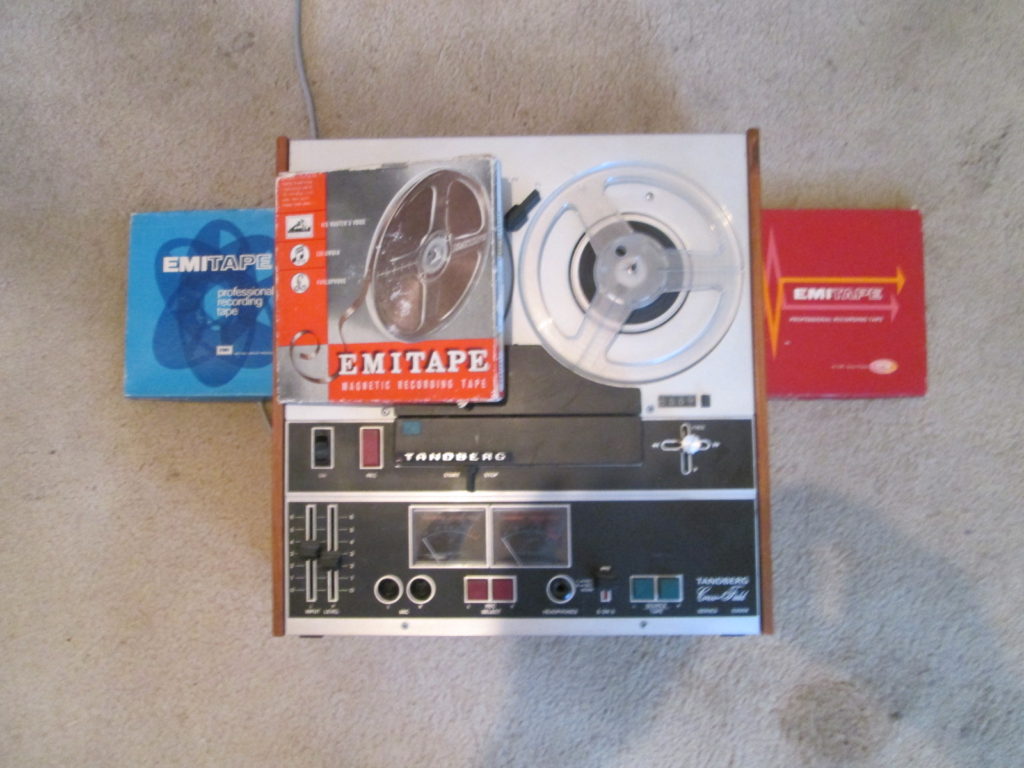
Alec Bray
My first (and only) tape recorder…
3 speed (7.5 ips , 3.25 ips and 1 and 7/8ths ips!)
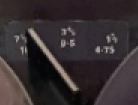
4 track – well, two tracks on half the width of the tape, then turn over the reels and record again in the other direction.
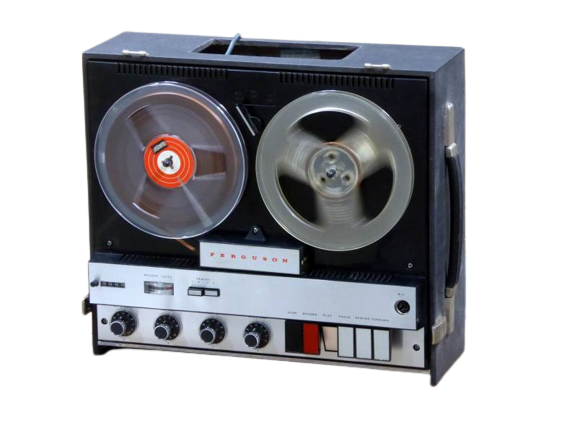
When I went to College, we took the feed from the not-selected record/replay head, fed this into a pre-amp and amplifier. We wildtracked a Transacord railway sounds LP onto the two (independent) tracks, and replayed through both replay heads to give a stereo effect – for a college production of “Point of Departure”.


